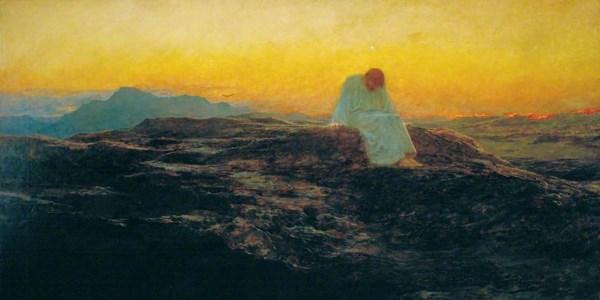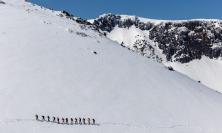We do not have one evangelist to escort us through Lent this year; instead, half of our Sunday gospels are narrated by Matthew, the other half by John. Peter Edmonds SJ explains how hearers of this series of readings follow Jesus from the desert to the tomb – a journey that begins just after Jesus’s baptism – and in so doing prepare to renew their own baptismal promises.
A desert, a mountain, a well, a pool, a tomb, a place of execution: these are the settings for the six gospel stories we hear on the Sundays of Lent in Year A. They form a catechesis, primarily for those who are to be baptised on Easter night at the Vigil service, but also for the rest of us who will be invited to renew our own baptismal promises at the same liturgy. If we make these gospel texts our own through personal reading, prayer and meditation, they can be a means to help us renew these promises with understanding, enthusiasm and conviction. They offer an itinerary which we can travel in our annual Lenten pilgrimage.
The desert (Matthew 4:1-11)
For we do not have a high priest who is unable to sympathise with our weaknesses. (Hebrews 4:15)
In the gospel reading for the First Sunday of Lent, we hear about the temptations of Jesus. He has gone into the desert. The desert was a place where, according to the prophet Hosea, God lured Israel in order to speak tenderly to her (Hosea 2:14): the desert is where we meet God. But the desert is also a place of testing: it was in the desert, God tells his people, that their ancestors tested him (Psalm 95:9). Israel was in the desert for forty years (Deuteronomy 8:2); Jesus was in the desert for forty days.
In the desert, Jesus lived in God’s presence. He had just heard the voice of God speaking at his baptism and it was the Spirit of God that brought him there. When we hear Jesus speak, he quotes words that God spoke through Moses in Deuteronomy (8:3; 6:13, 16). But he was also tempted and tested by the devil: ‘if you are the Son of God’, the devil taunted him, just as his enemies would mock him when later he hung on the cross (Matthew 27:40). But Jesus refused every temptation the devil put before him. He would not work wonders for himself or test God or indulge in false worship.
Lent for all of us is a period when we are to live closer to God. We pray that we may deepen our understanding of our own Christian calling and dignity. Because of our baptism, we are all children of God. We know, as Jesus knew, that we do not live by bread alone but by every word that comes from the mouth of God. We do not put ourselves in situations from which only God can rescue us, and we do not worship anything or anyone but God alone.
The mountain (Matthew 17:1-9)
‘We ourselves heard this voice come from heaven while we were with him on the holy mountain.’ (2 Peter 1:18)
In the previous Sunday gospel, we were with Jesus in the desert. He was alone, bereft of human company. In his solitude, he was tested by the devil. On the Second Sunday of Lent, we accompany him up a mountain. He takes with him three disciples with whom we can identify. Peter, their leader, had recently confessed Jesus as ‘Son of the Living God’. All the disciples had been shaken when, for the first time, Jesus had spoken of his coming suffering and death, and had warned them that to follow him was to take up the cross. The days of the Passion were drawing near.
On the mountaintop, Jesus’s figure reflected the appearance of God in the brightness of his face and the sheen of his clothing (Ezekiel 8:2). He was not alone. Moses, the great law-giver, and Elijah, the mighty prophet, kept him company. Peter reacted as if they were already in heaven where, according to popular belief, the blessed dwell in tents. But at once a voice was heard, speaking about Jesus. He was indeed the Son of God, as Peter had declared, but he was also the one whose voice was to be obeyed: ‘Listen to him’. God now spoke, not as in the past through Moses, but through Jesus, and the disciples were only too aware that his message was that of the cross. He was the prophet whom God had promised Moses that he would send, whom the people were to heed (Deuteronomy 18:15).
The disciples in fear fell to the ground, just as Daniel had done when he heard the voice of God (Daniel 10:9-10). Jesus approached them, as he would at the end of the gospel (Matthew 28:18) and touched them, with words of comfort and encouragement. The sight of Jesus was reassurance enough. His presence meant consolation, not threat. In the second week of Lent, we join those disciples on the mountain with Jesus, so that we may walk with confident steps to meet the challenges with which life presents us.
The well (John 4:5-42)
‘If you knew the gift of God, and who it is that is saying to you . . .’ (John 4:10)
On the Third Sunday of Lent, we meet Jesus at a well in Samaria. He is on the mission given to him by his Father; his food was ‘to do the will of the one who sent him’. He is weary and thirsty. He finds himself in a foreign and hostile place because ‘Jews do not share things in common with Samaritans’. It is the hottest time of day, the sixth hour, the same time at which Pontius Pilate would hand him over for crucifixion (John 19:14).
At the well, Jesus meets a woman. We do not know her name. She came alone as if shunned by other women in her town. She refuses Jesus’s request for a drink. But Jesus insists that he has a gift for her, ‘living water’. In this Gospel of John, this signifies either the teaching that Jesus has to give, or the Holy Spirit, symbolised by the water that would pour out of his side once he had died (John 7:38; 19:34). Thanks to his patient conversation with this woman, she asks Jesus for this water. She also deepens her understanding of his person. He was indeed greater than ‘our ancestor Jacob’; he was a prophet and he was the Messiah whom she and her people were expecting. Convinced by Jesus, she rushed back into town and, now on a mission herself, she urged her people to come and meet Jesus for themselves.
Jesus and the woman are the major characters in the story. But we should not overlook the part played, or rather not played, by the disciples of Jesus. Their only interest seems to be in physical food. They leave Jesus alone at the well while they go off to buy food and on their return, they want Jesus to eat their food. The other participants in the story are the townsfolk. They invite Jesus to stay in their town, and are so fascinated by what he has to tell them that they inform the woman that they need her help no longer. For them he is ‘the Saviour of the world’. On the Third Sunday of Lent, may we open ourselves to Jesus who is still on a mission in our world. May we welcome the living water which he offers us in word and sacrament.
The pool (John 9:1-41)
‘I am the light of the world’ (John 8:12)
For the Fourth Sunday of Lent, we move from remote Samaria to the hustle of the city of Jerusalem in festival mode. The whole city was illuminated for the feast of Tabernacles. This was the occasion when Jesus proclaimed himself to be ‘the light of the world’ (John 8:12). This brought him into controversy with his religious critics, the Pharisees. He responded not only in word, but in action, too, as he performed the sign of giving sight to a man blind from birth by the pool of Siloam. Then Jesus disappeared from the story, and left the man to fend for himself as he faced questioning from his neighbours and from the enemies of Jesus who turned their wrath on him rather than on Jesus.
As we hear the man dealing with these questions, we learn how Jesus not only gave physical sight, but was also the agent of spiritual sight. In answering his neighbours, the once blind man described Jesus as the ‘man called Jesus’. When interrogated by the Pharisees, he called Jesus a prophet. Later he would give ‘glory to God’ by defending Jesus against a charge of being a sinner. He had become a theologian. Finally, when Jesus sought him out, the man called him his Lord, knelt and worshipped him. He now believed; he is a model for all who hear this gospel story (John 20:31).
But if for this man the light grew brighter as the story proceeded, others stumbled from one degree of darkness to another. Again this darkness was spiritual rather than physical. The neighbours in the story became divided among themselves; the parents of the blind man lacked courage to admit what they knew; the Pharisees who criticised Jesus argued among themselves and denied that the man had been cured at all. The question that began the story was, ‘Who sinned?’ By its end, we know that the ones who sinned were these Pharisees. In contrast to the man who was born blind, they failed to respond to the one who is ‘the light of the world’, in whose name we carry our lighted candles on Easter night.
The tomb (John 11:1-45)
‘I am the resurrection and the life’ (John 11:25)
Two weeks in advance of the festival of the death and resurrection of Jesus Christ, we are invited to prepare for it by listening to the story of Lazarus, the man who died but was called back by Jesus from the grave to life. The story is a complex one with many characters. Jesus himself dominates the drama and at its centre, proclaiming himself as ‘the resurrection and the life’. Two characters in particular, the sisters of Lazarus, Martha and Mary, struggled to accept this claim.
Each sister responds in her own way to the death of her brother. Martha expresses her belief in resurrection at the last day, and on hearing Jesus’s claim to be ‘the resurrection and the life’ she expresses her faith in him as ‘the Son of God who was to come into the world’. Yet when Jesus comes to the tomb, she seems to have forgotten her faith in him and warns Jesus that her brother has been dead for four days. Mary, introduced at the beginning of the story as the person who had anointed the Lord with ointment before he went to his death, comes to the tomb and, together with other mourners, gives way to her tears. She too seems to lack faith in Jesus as ‘the resurrection and the life’.
Jesus wept too, but a different word for his weeping is used in the original Greek. Many believe that Jesus wept because of the faithless response of the two sisters to the death of their brother; their behaviour when confronted with death was not what we would expect of people who accept Jesus as ‘the resurrection and the life’. The quality of this new resurrected life is hinted at in the appearance of Lazarus as he emerged from the tomb. He was still wearing his grave clothes and had returned to this life only to die again. He experienced resuscitation rather than resurrection. In contrast, when Jesus rose from the tomb on Easter Day, he left his grave clothes behind in the tomb (John 20:6-7). The new life of resurrection which he now lived teaches us about the new life which is God’s gift to us as a result of the events we commemorate yearly at Easter time.
Golgotha (Matthew 26:14-27:66)
‘Truly this man was God’s Son’ (Matthew 27:54)
The story of the suffering and death of Jesus is the most extended narrative in each of the gospels; on Palm Sunday in Year A we hear Matthew's version, the longest of the four. He offers us a revision of Mark’s account. Mark had not played down the horror of the story; he portrayed Jesus as silent, despised and deserted until the moment of death, when, through the tearing of the temple veil and the centurion's confession, God vindicated his cause as a prelude to the resurrection (Mark 14:1-15:47).
Matthew's account helps us understand better the meaning of the events. Jesus announced at the start of the drama, ‘My time is near’ (Matthew 26:18). At his Last Supper with his disciples, he explained the sacrificial nature of his death; it was for the ‘forgiveness of sins’ (26:28). At his arrest in Gethsemane, he admitted that twelve legions of angels were his for the asking (26:53); his refusal to resist reflected his own teaching in his Sermon on the Mount (5:39). As he died, his enemies mocked him as ‘Son of God’ (Wisdom 2:13), but we know from the story of his temptations that he will not misuse this intimacy with his Father for his own benefit (Matthew 4:6-7). His divine sonship was proclaimed at the beginning of the gospel (2:15; 3:17) and his disciples recognised it during the ministry (14:33; 16:16). The title on the cross, ‘Jesus, king of the Jews’ was no error, since it was as a child king that the wise men from the East had given him gifts (2:2) and he had entered Jerusalem as a humble king riding on a donkey (21:5-9; Zechariah 9:9).
Old Israel might seem to have formally rejected Jesus before Pilate, treating him as an impostor (27:25). But God had forgiven sinful Israel in the past and would do so again (Jeremiah 31:34): we must remember Paul’s words that ‘the gifts and the call of God are irrevocable’ (Romans 11:29). As for other nations, these are symbolised by Pilate's wife who pleaded to her husband for Jesus, ‘that innocent man’ (Matthew 27:19). Finally, the earthquake and resurrection of the just which Matthew alone reports together with the death of Jesus, show that the turning point of the ages, expected in the future, had already come (27:51-53). The world has been created anew (Galatians 6:15).
Peter Edmonds SJ is a member of the Mount Street Jesuit Community.






